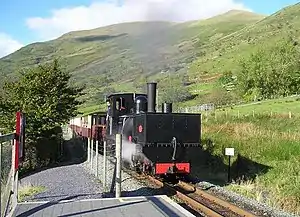Tasmanian Government Railways K class
The Tasmanian Government Railways K class was a class of 0-4-0+0-4-0 Garratt locomotives operated by the Tasmanian Government Railways from 1909 – the first Garratt locomotives built.
| Tasmanian Government Railways K class | |||||||||||||||||||||||||||||||||||||||
|---|---|---|---|---|---|---|---|---|---|---|---|---|---|---|---|---|---|---|---|---|---|---|---|---|---|---|---|---|---|---|---|---|---|---|---|---|---|---|---|
 Works photograph of K1 | |||||||||||||||||||||||||||||||||||||||
| |||||||||||||||||||||||||||||||||||||||
| |||||||||||||||||||||||||||||||||||||||
| |||||||||||||||||||||||||||||||||||||||
| |||||||||||||||||||||||||||||||||||||||
Overview


Although considered the first Garratt locomotives, they did in fact differ in two important details from Herbert Garratt's original concept. First: they are compound locomotives, with two high-pressure cylinders on the rear engine, and a pipe leading to two larger low-pressure cylinders on the front engine; second: both sets of cylinders were placed facing each other inside their engine units, rather than facing out as in all other Garratts. This was a problem on the rare warm days on the West Coast Range in Tasmania, as one pair of cylinders was under the cab, making the cab uncomfortably hot.[1][2][3][4]
The North East Dundas Tramway on which they worked traversed some of the most rugged terrain in the world served by a railway at the time. It featured long stretches of 1-in-25 grades, high trestle bridges and 30-metre-radius reverse curves.[5]
After the line closed in 1929, the boiler of K1 was sold to a sawmill, and in 1947 K1 was sold to its builder Beyer, Peacock & Co, with the boiler and boiler cradle of K2 attached and repatriated back to England. Beyer, Peacock & Co closed in 1966. K1 was sold to the Ffestiniog Railway for 1500 GBP after an appeal for funds. However, it was too tall and wide for use within the restricted loading gauge, and after ten years of storage at Porthmadog, it was lent to the National Railway Museum (NRM), York where it was cosmetically restored.[2][6][7]
As the Welsh Highland Railway (WHR) rebuilding project reached fruition, K1's potential for the line was recognised and in 1995 it left the NRM. A new boiler was found to be required. Parts were restored at various locations, with K1 reassembled at Boston Lodge.[8] After conversion to oil-firing, it steamed again in 2004 and finally received HM Railway Inspectorate approval in September 2006 to haul trains.[9] A conversion back to coal firing was completed in August 2007 together with some other work which allowed it to appear at the Superpower weekend in early September. It entered regular passenger service in October 2007.[2][6][10]
In 2014, K1's boiler certificate expired and it was withdrawn for overhaul.[6][11] A full boiler shell exam is required. However, because the locomotive does not meet the operational requirements of the WHR (it cannot haul the passenger loads required) and with the WHR's workshops fully committed to other overhaul projects, in 2019 it moved to the Statfold Barn Railway for a period of ten years. A boiler overhaul was started in January 2020 .[12]
References
- Turner, Jim (1997). Australian Steam Locomotives 1896-1958. Kenthurst: Kangaroo Press. p. 50. ISBN 086417778X.
- Oberg, Leon (2010). Locomotives of Australia 1850s-2010. Dural: Rosenberg Publishing. pp. 143/144. ISBN 9781921719011.
- K1 The World's First Garratt West Highand Railway Society
- "Steam Locomotives of the Tasmanian Government Railways and its Constituents" Australian Railway History issue 917 March 2014 page 19
- Murdoch, Geoff (1988). Tasmania's Hagans: the North East Dundas Tramway: Articulated J Class. Geoff Murdoch. pp. 11–13. ISBN 0646334425.
- K1 The Original Garratt - Maintenance & Support West Highland Railway Society
- K1 Back in the UK West Highland Railway Society
- K1: Rebuilding the Chassis West Highland Railway Society
- K1: Testing & Commissioning West Highland Railway Society
- K1 in WHR Service West Highland Railway Society
- K1 Working Parties West Highland Railway Society
- K1 Moves to Stalford for Cosmetic Restoration and Display Steam Railway issue 500 December 2019 page 20
Further reading
- Belibin, Bruce and McKillop, Bob - K1 steams again Light Railways, Number 193 February 2007 pp. 3–7
- Cénac, Dr Christian (1996). "K1": 1ère Garratt en Tasmanie (in French). Toulouse, France: C. Cénac. ISBN 2950540333.
- Durrant, A E (1969). The Garratt Locomotive. David & Charles Locomotive Studies. Newton Abbott, Devon, UK: David & Charles. OCLC 729984551.
- Durrant, A E (1981). Garratt Locomotives of the World (rev. and enl. ed.). Newton Abbot, Devon, UK; North Pomfret, Vt, USA: David & Charles. ISBN 0-7153-7641-1. OCLC 9326294.
- Hills, Richard L (2000). The Origins of the Garratt Locomotive. East Harling, Norfolk, UK: Plateway Press. ISBN 1871980437.
- Manning, Peter (2009). The Anatomy of a Garratt: A detailed look at the design and construction of K1. The original Garratt locomotive built for the Tasmanian Government Railways - A century ago. Coromandel Valley, SA, Australia: Peter Manning Design & Drafting. ISBN 9780980621228.
External links
- Garratt locomotives Rail Tasmania
- TGR K class Drawing
- Drawing of TGR K class